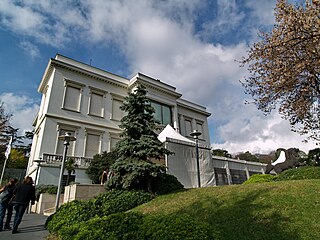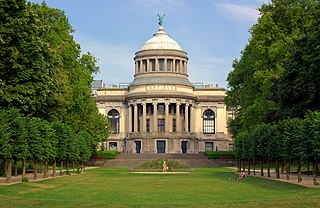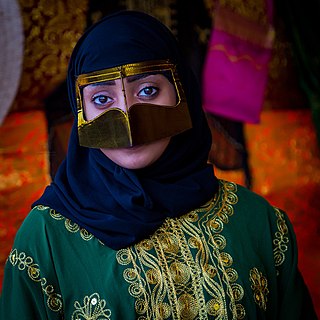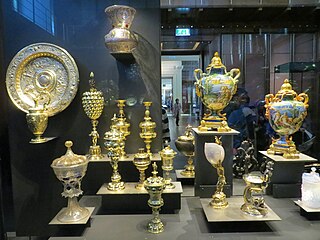
Islamic art is a part of Islamic culture and encompasses the visual arts produced since the 7th century CE by people who lived within territories inhabited or ruled by Muslim populations. Referring to characteristic traditions across a wide range of lands, periods, and genres, Islamic art is a concept used first by Western art historians in the late 19th century. Public Islamic art is traditionally non-representational, except for the widespread use of plant forms, usually in varieties of the spiralling arabesque. These are often combined with Islamic calligraphy, geometric patterns in styles that are typically found in a wide variety of media, from small objects in ceramic or metalwork to large decorative schemes in tiling on the outside and inside of large buildings, including mosques. Other forms of Islamic art include Islamic miniature painting, artefacts like Islamic glass or pottery, and textile arts, such as carpets and embroidery.

Islamic pottery occupied a geographical position between Chinese ceramics, and the pottery of the Byzantine Empire and Europe. For most of the period, it made great aesthetic achievements and influence as well, influencing Byzantium and Europe. The use of drinking and eating vessels in gold and silver, the ideal in ancient Rome and Persia as well as medieval Christian societies, is prohibited by the Hadiths, with the result that pottery and glass were used for tableware by Muslim elites, as pottery also was in China but was much rarer in Europe and Byzantium. In the same way, Islamic restrictions greatly discouraged figurative wall painting, encouraging the architectural use of schemes of decorative and often geometrically patterned titles, which are the most distinctive and original speciality of Islamic ceramics.

The Sabancı University Sakıp Sabancı Museum is a private fine arts museum in Istanbul, Turkey, dedicated to calligraphic art, religious and state documents, as well as paintings of the Ottoman era. The museum was founded by Sakıp Sabancı, and was opened in June 2002. Aside from permanent exhibitions, the museum also hosts national and foreign temporary exhibitions and, hosts cultural events on the weekends.

Hijazi script is the collective name for several early Arabic scripts that developed in the Hejaz, a region that includes the cities of Mecca and Medina. This type of script was already in use at the time of the emergence of Islam. A calligraphic Hijazi script is called a Ma'il script ; these are found in a number of the earliest Qur'anic manuscripts. The two terms are often used interchangeably.

The Department of Asia in the British Museum holds one of the largest collections of historical objects from Asia. These collections comprise over 75,000 objects covering the material culture of the Asian continent, and dating from the Neolithic age up to the present day.

The Department of the Middle East, numbering some 330,000 works, forms a significant part of the collections of the British Museum, and the world's largest collection of Mesopotamian antiquities outside Iraq. The collections represent the civilisations of the ancient Near East and its adjacent areas.

The Art & History Museum is a public museum of antiquities and ethnographic and decorative arts located at the Parc du Cinquantenaire/Jubelpark in Brussels, Belgium. The museum is one of the constituent parts of the Royal Museums of Art and History (RMAH) and is one of the largest art museums in Europe. It was formerly called the Cinquantenaire Museum until 2018. It is served by the metro stations Schuman and Merode on lines 1 and 5.

Battoulah, also called Gulf Burqah, is a metallic-looking fashion mask traditionally worn by Khaleeji Arab and Bandari Persian Muslim women in the area around the Persian Gulf.

The Sharjah Museum of Islamic Civilization is a museum in Sharjah, United Arab Emirates (UAE). The museum, opened in 2008, covers Islamic culture, with more than 5,000 artifacts from the Islamic world. Objects include calligraphy, carvings, ceramics, coins, glass, manuscripts, metalwork, and scientific instruments. It was formerly known as the Islamic Museum and opened in 1996 before being moved and re-housed in the current building.

Chinese influences on Islamic pottery cover a period starting from at least the 8th century CE to the 19th century. The influence of Chinese ceramics on Islamic pottery has to be viewed in the broader context of the considerable importance of Chinese culture on Islamic arts in general.

In 1898, Baron Ferdinand de Rothschild bequeathed to the British Museum as the Waddesdon Bequest the contents from his New Smoking Room at Waddesdon Manor. This consisted of a wide-ranging collection of almost 300 objets d'art et de vertu, which included exquisite examples of jewellery, plate, enamel, carvings, glass and maiolica. One of the earlier objects is the outstanding Holy Thorn Reliquary, probably created in the 1390s in Paris for John, Duke of Berry. The collection is in the tradition of a schatzkammer, or treasure house, such as those formed by the Renaissance princes of Europe; indeed, the majority of the objects are from late Renaissance Europe, although there are several important medieval pieces, and outliers from classical antiquity and medieval Syria.

Edmund Robert Anthony de Unger was a Hungarian-born property developer and art collector. In London he built up the Keir Collection, one of the greatest post-war collections of Islamic art, bequeathed in 2008 to the Pergamon Museum of Islamic Art in Berlin. The arrangement for the museum to curate the collection came to an end in July 2012. The collection is now hosted by the Dallas Museum of Art as of May 2014 for a 15-year renewable loan.

The Blue Quran is an early Quranic manuscript written in Kufic script. The dating, location of origin, and patron of the Blue Quran are unknown and have been the subject of academic debate, though it is generally accepted that the manuscript was produced in the late 9th to mid-10th century in either Kairouan, Tunisia or Cordoba in Umayyad Spain. The manuscript is among the most famous works of Islamic calligraphy, notable for its gold lettering on a rare indigo-colored parchment.

Raqqa ware or Rakka ware is a style of lustreware pottery that was a mainstay of the economy of Raqqa in northeastern Syria during the Ayyubid dynasty. Though the ceramics were varied in character, they have been identified during the 20th century by on-site excavations that securely linked the highly sought-after surviving pieces to Raqqa. However, Raqqa was not the only production site and Raqqa Ware has been found at various locations on the Euphrates, such as Qala'at Balis. The pieces typically have a white body covered in siliceous glaze, with decorations in brown luster or blue and back underglaze. The glazes most often vary in both transparency and shades of turquoise, however other colors were also used. Raqqa ware typically consists of kitchen items such as jars, dishes, and bowls with basic shapes that served everyday purposes such as storage. Some sculptural figures exist, and though their original purpose is debated, they are thought to be toys or decorations for the home.
Jehan Rajab was a Brazil-born Kuwaiti author of British origin. She stayed in Kuwait from 1959 before she wrote her book titled Invasion Kuwait: An English Woman's Tale which was an account of life in Kuwait during the Iraqi invasion of Kuwait from her own point of view and married Tareq Rajab in 1955 in England who was the 5th Kuwaiti to marry a western woman & the 1st Kuwaiti to go abroad to study Art and archeology. In accordance with Kuwait law, through her marriage she was able to gain Kuwaiti citizenship. She worked as the first director of the department of antiquities and museums of Kuwait. Jehan stayed in Jamaica, Portugal, and the Cape Varde Island during her childhood. She had 3 children including Dr. Ziad Rajab who is the current director of the New English School. She had a hard time settling in Kuwait due to the lack of facilities and found it harder to adjust to the cool winter than hot summers. She co-founded the Tareq Rajab Museum and The New English school with her husband in 1980 and 1969 respectively. Jehan also appeared in a documentary called Class of 1990. She died on 5 April 2015 at the age of 81. Her funeral took place in Jabriya.

Basil Al Bayati is an Iraqi-born architect and designer who has lived and practiced for the most part in Europe, in particular, London and who Neil Bingham, in his book 100 Years of Architectural Drawing: 1900–2000, has described as "an architect in whom East meets West." Al Bayati is considered to be one of the most important names in metaphoric architecture, an area he was at the forefront of pioneering, which uses analogy and metaphor as a basis for architectural inspiration as well as the "exploration of geometric and design patterns found in nature".

Persian art or Iranian art has one of the richest art heritages in world history and has been strong in many media including architecture, painting, weaving, pottery, calligraphy, metalworking and sculpture. At different times, influences from the art of neighbouring civilizations have been very important, and latterly Persian art gave and received major influences as part of the wider styles of Islamic art. This article covers the art of Persia up to 1925, and the end of the Qajar dynasty; for later art see Iranian modern and contemporary art, and for traditional crafts see arts of Iran. Rock art in Iran is its most ancient surviving art. Iranian architecture is covered at that article.

The Khalili Collections are eight distinct art collections assembled by Nasser D. Khalili over five decades. Together, the collections include some 35,000 works of art, and each is considered among the most important in its field.

The Nasser D. Khalili Collection of Islamic Art includes 28,000 objects documenting Islamic art over a period of almost 1400 years, from 700 AD to the end of the twentieth century. It is the largest of the Khalili Collections: eight collections assembled, conserved, published and exhibited by the British scholar, collector and philanthropist Nasser David Khalili, each of which is considered among the most important in its field. Khalili's collection is one of the most comprehensive Islamic art collections in the world and the largest in private hands.






























